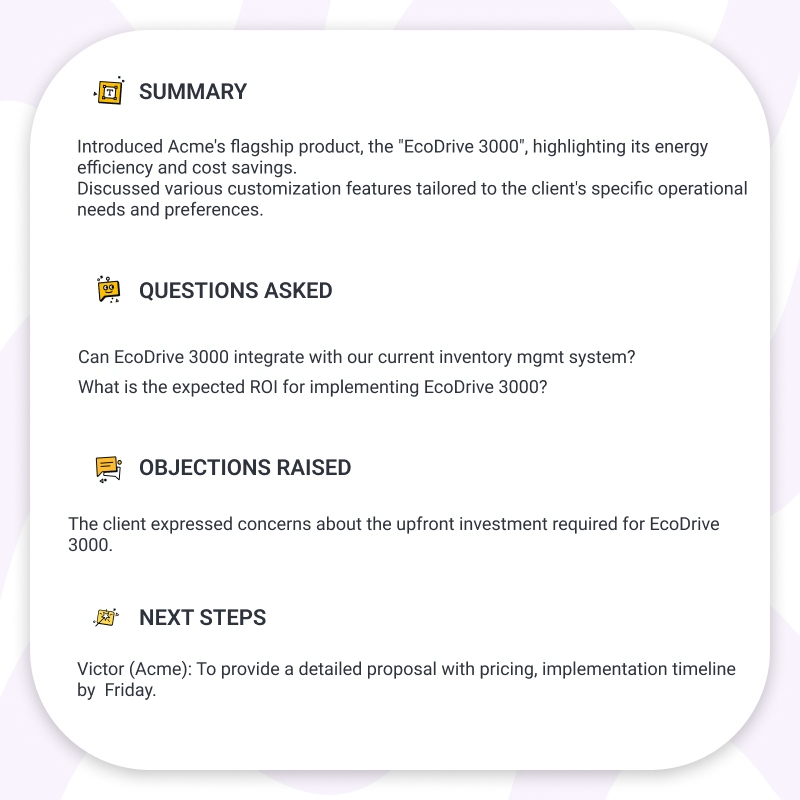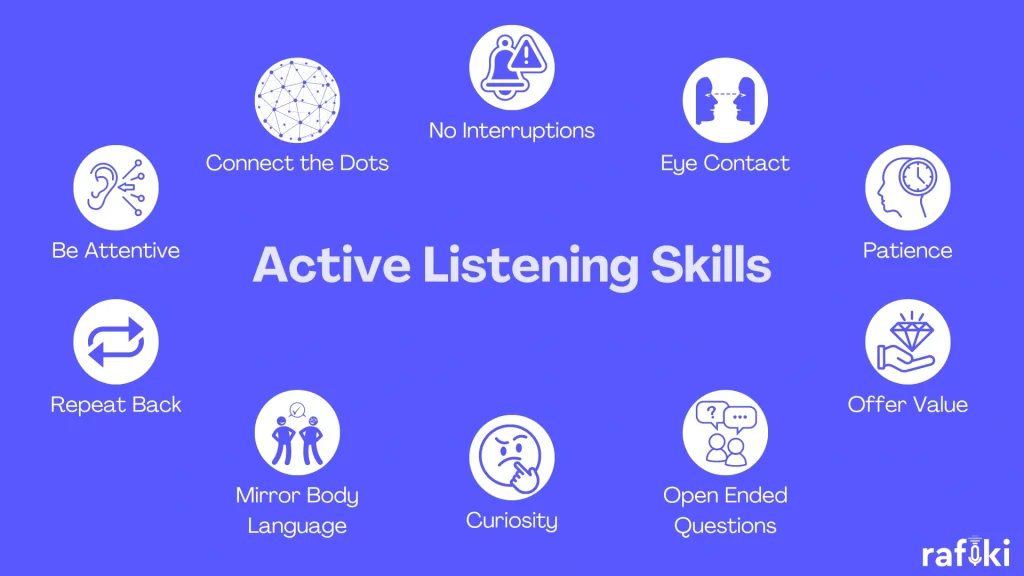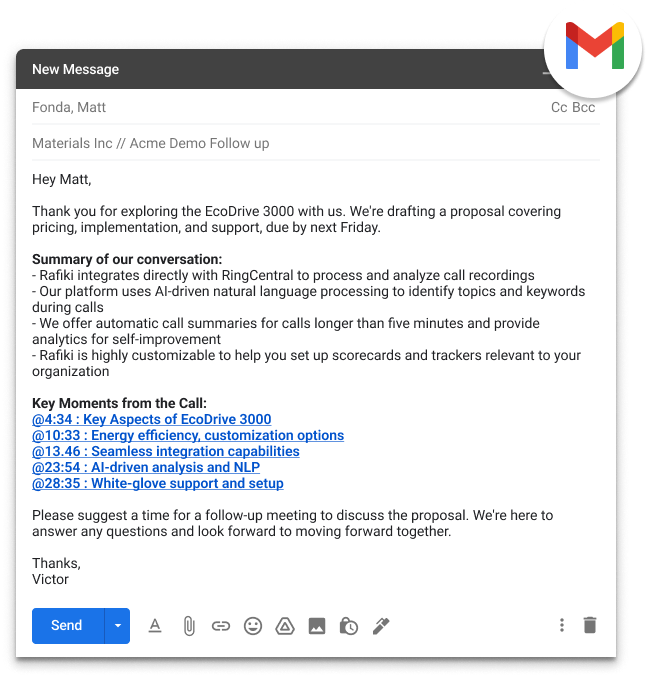Why Rafiki
Pricing


Pricing
Solutions

RevOps Leaders
Synchronize revenue generating functions

SDR Leaders
Get your team aligned and Coach your Reps 3x faster at scale

Sales Leaders
Unlock pipeline truth, drive confident forecasts

If you’re a fan of Friends, you certainly remember this scene.

We all wish it was that easy to build rapport with prospects. It’s not. But by asking the right questions, you can get them to open up and get a headstart on earning their trust.
Here are 15 questions to help you lock on to the right conversations:
This question gets the prospect talking about their world, their specific challenges, and their goals. By understanding their day-to-day struggles, you can demonstrate empathy and show how your solution can alleviate those specific pain points.
Ask this question early in the conversation, after some initial introductions and pleasantries. It sets the stage for a more in-depth discussion about their needs.
Pay close attention to the specific challenges they mention. You can then say something like, "That sounds frustrating. Have you ever considered [mention a relevant feature of your solution] as a way to address that?"
Understanding a prospect's goals allows you to tailor your pitch to their specific needs. You can show how your solution can directly contribute to their success.
Ask this question after you have gained a basic understanding of their challenges (from question 1). This way, you can connect their goals to the solutions you offer.
Once they share their goals, highlight how your solution can help them achieve those goals. For example, you could say, "Interesting! Our product has helped many companies achieve similar goals by [mention a specific benefit]. Would you be interested in learning more about how it can help you reach your targets?"
By using Rafiki's Smart Call Summary, you can easily capture these key points from your conversation and use them to build rapport with prospects.

This question pushes the conversation beyond simply identifying challenges and moves towards exploring potential solutions. By asking about their ideal solution, you can gauge how well your offering aligns with their needs. The second variation allows you to delve deeper into a specific pain point and understand its impact.
Ask this question after you've discussed their challenges and goals (from previous questions). This way, you can see how their ideal solution aligns with what you offer.
Listen closely to their description of an ideal solution or the specific situation they describe. Find commonalities between their needs and your product's functionalities. You can then say, "That's interesting! Our solution offers [mention a relevant feature] which can help address exactly what you described." This builds a meaningful connection and rapport with prospects.
Understanding their current approach and evaluation criteria allows you to position your solution effectively. You can highlight how your offering stands out from any existing solutions they might be considering.
Ask this question after you've presented your solution and its benefits. This allows you to gauge their interest level and identify any potential competitors.
If they mention existing solutions, identify areas where your product offers a clear advantage. You can say, "I see you mentioned [competitor's name]. While they offer X, our solution goes a step further by providing Y, which directly addresses your concern about [challenge]."
By acknowledging potential hesitations, you show that you understand the buying process and their concerns. This builds trust and rapport with prospects. The second variation helps pinpoint a specific challenge you can address with your solution.
Ask this question after you've presented your solution in detail. This allows them to voice any reservations they might have.
Address them directly and honestly. Highlight features of your solution that specifically alleviate their worries. You can say, "That's a common concern, and I understand your hesitation. However, with our solution's [mention relevant feature], you can be confident that [explain how it resolves their concern]."
Understanding the buying process and key decision-makers allows you to tailor your approach. Knowing the next steps helps you stay aligned with their timeline and proactively provide any necessary information.
Ask this towards the end of the conversation, when you've established a good rapport and they seem receptive to your solution.
Offer to connect them with relevant resources or answer any questions they have about the next steps. You can say, "Thanks for sharing that! I understand that [decision-maker name] would also be involved. I'd be happy to connect you with some case studies or testimonials that showcase how our solution benefitted companies in a similar situation."
Understanding their existing experience and vendor selection criteria allows you to position your company as a trusted partner. You can highlight your strengths and showcase how you surpass any past experiences they might have had. This helps build rapport with prospects.
Ask this question mid-conversation, after you've gained a good understanding of their challenges and goals. This way, you can tailor your response to their specific situation.
If they mention negative experiences, acknowledge their concerns and emphasize how your company is different. You can say, "I understand that your previous experience with [solution type] wasn't ideal. At our company, we prioritize [mention a core value] which ensures [explain a benefit]." If they mention specific criteria, highlight how your company excels in those areas.
Negative experiences are especially important when a customer is talking about them. This is where those who can actively listen can make all the difference. But active listening can sound deceitfully simple. Here are the skills you need for active listening:

By focusing on their definition of success, you demonstrate a commitment to their long-term goals. Asking how you can support them shows that you're invested in building a strong relationship and a successful rapport with prospects.
Ask this question towards the end of the conversation, after you've presented your solution and addressed any concerns.
Align your solution's benefits with their goals. You can say, "That's a great definition of success! Our solution has helped many companies achieve similar goals by [mention specific benefits]." Regarding their evaluation process, offer relevant resources or schedule a follow-up meeting to answer any questions. You can say, "We understand that evaluation is important. I'd be happy to provide you with some additional resources or schedule a follow-up call to answer any questions you might have as you move forward."
It sounds simple and even generic, but there’s a reason it’s popular. This question shows that you're genuinely interested in their needs and demonstrates a willingness to go the extra mile. It also provides an opportunity to address any lingering concerns they might have before the call ends.
Ask this towards the very end of the conversation, after you've discussed their challenges, goals, and your solution.
If they have additional questions, answer them thoroughly and clearly. If they don't have any questions, you can offer next steps. You can say, "Is there anything else I can help you with today? If not, I'd be happy to schedule a follow-up call to answer any questions you might have as you move forward in your evaluation process."
This question shows that you value building a long-term relationship, not just a one-time sale. Offering relevant industry updates or success stories demonstrates your continued commitment to their success.
Ask this after a positive conversation where they expressed interest in your solution or seemed receptive to learning more.
If they agree to stay connected, ask for their preferred method of contact (email, newsletter, etc.). For the case study, offer to send it electronically or schedule a quick follow-up call to discuss it in more detail. You can say, "Great! I'd be happy to keep you updated on industry trends and advancements. What's the best email address to reach you at?"
Don't underestimate the power of a well-crafted follow-up email after your conversation. Rafiki's Smart Follow Up can automatically generate a personalized email that summarizes key points from the call and highlights your solution's benefits. This keeps you top-of-mind and increases your chances of securing the next steps.

This question positions you as a thought leader and industry expert. It also opens the door for a more casual conversation and can help you identify areas of common ground with the prospect.
Ask this mid-conversation, after you've established a rapport and they seem comfortable talking openly. Choose a topic that's relevant to their industry or the challenges they mentioned.
Share your own insights on the topic and ask follow-up questions to keep the conversation flowing. You can say, "That's an interesting perspective! I recently came across an article that discussed [mention a related point]. Have you had a chance to see it?" This can lead to a more engaging dialogue and build stronger rapport.
Asking about their career path or passions shows genuine interest in them as a person, not just a potential customer. This can help you connect with them on a deeper level and build trust.
Ask this towards the end of the conversation, after you've covered the business aspects but there's still a good rapport. Be mindful of the time and keep it brief.
Find commonalities or interesting aspects of their story and ask follow-up questions. You can say, "That's fascinating! I'm also interested in [mention a shared interest]. What got you into that?" This can help you connect on a personal level and create a more memorable interaction.
This question helps you gauge their level of understanding and interest. Knowing their key takeaways allows you to tailor your follow-up communication. Additionally, it provides an opportunity to address any lingering questions they might have about your solution. A key to building rapport with prospects is to ensure there's nothing unsaid that makes them anxious.
Ask this towards the very end of the conversation, after you've summarized the key points and addressed their concerns.
If they mention a specific takeaway, acknowledge it and build upon it. You can say, "That's great to hear! Our solution directly addresses that by [mention a relevant feature]." If they have lingering questions about your solution, answer them clearly and concisely.
Connecting them with a satisfied customer builds trust and social proof. It allows them to hear a real-world example of how your solution helped a similar company. Following up on resources you mentioned shows your attentiveness and ensures they have the information they need to move forward.
Ask this after you've presented your solution and addressed their concerns. For the customer connection, gauge their level of interest first.
If they're open to a customer connection, facilitate the introduction and ensure both parties have contact information. For website resources, ask if they have any questions about what they found. You can say, "No problem at all! Our website has a wealth of information on [mention specific sections]. Did you have a chance to take a look, and do you have any questions about what you saw?"
Understanding their decision-making timeline allows you to tailor your follow-up strategy. You can proactively provide additional information or schedule a demo at a convenient time to keep the momentum going.
Ask this towards the end of the conversation, after you've discussed their evaluation process (question #6).
If they have a specific timeline, offer to schedule a follow-up call or meeting within that time frame. You can say, "Thanks for letting me know. Within that time frame, would you be interested in a product demo to see how our solution can specifically address your needs?" If they don't have a set timeline, you can offer to stay connected and provide updates on relevant industry trends or success stories (question #10).
By incorporating these powerful questions into your sales conversations, you'll be well on your way to building rapport with prospects, understanding prospect needs, and ultimately, closing more deals. However, remembering these questions and effectively navigating conversations can be a challenge.
Explore how Rafiki empowers sales reps to engage prospects, build lasting relationships, and close deals faster with a free 14-day trial. Sign up today and see the Rafiki difference!
Build Rapport With Prospects